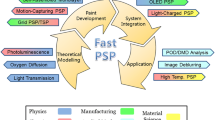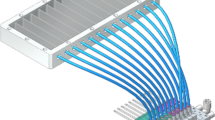Abstract
Pressure-sensitive paint (PSP) technique was employed to experimentally investigate the aerodynamic force effect of vacuum plume in this study. The characterization and comparison for two types of PSP were firstly conducted in an air pressure range from 0.05 to 5000 Pa. The PSPs were prepared using PtTFPP as the active dye and different binders, i.e., polymer-ceramic (PC) and poly(1-trimethylsilyl-1-propyne) [poly(TMSP)]. The static calibrations showed that PtTFPP/poly(TMSP) had a higher pressure sensitivity and a lower temperature dependency compared to PtTFPP/PC in this pressure range. The pressure distributions of a single and two interacting plumes impinging onto a flat plate model were measured using PSP technique. The experimental data were compared to numerical solutions that combined both the computed fluid dynamics (CFD) and direct simulation Monte Carlo (DSMC) methods. Remarkable agreements were achieved, demonstrating the feasibility and accuracy of the numerical approach. Finally, the aerodynamic force effect of interacting plumes at different separation distances was investigated numerically.
Similar content being viewed by others
References
Bird G A. Approach to translational equilibrium in a rigid sphere gas. Phys Fluids, 1963, 6: 1518–1519
Bird G A. Shock-wave structure in a rigid sphere gas. In: Proceedings of the 4th International Symposium on Rarefied Gas Dynamics. Toronto, 1965. 216
Bird G A. Molecular Gas Dynamics. Oxford: Clarendon Press, 1976. 250
Boyd I D, Penko P F, Carney L M. Efficient Monte Carlo simulation of rarefied flow in a small nozzle. In: Proceedings of 5th Joint Thermophysics and Heat Transfer Conference. Searrle, 1990
Kannenberg K C, Boyd I D. Three-dimensional Monte Carlo simulations of plume impingement. J Thermophys Heat Transfer, 1999, 13: 226–235
Cai G B, Su W, Hou F L. Theoretical development for DSMC local time stepping technique. Sci China Tech Sci, 2012, 55: 2750–2756
He B, Zhang J, Cai G. Research on vacuum plume and its effects. Chin J Aeronaut, 2013, 1: 27–36
Dagum L, Zhuh S K. Three-dimensional particle simulation of high altitude rocket plumes. AIAA Paper No. 92-2913, 1992
Dagum L, Zhu S K. Direct simulation Monte Carlo simulation of the interaction between rarefied free jets. J Spacecraft Rockets, 1994, 6: 960–964
Xiao Z, Cheng H, Zhou H. Plume interaction in parallel multithrusters propulsion system and the effect on backflow. AIAA Paper No. 2006-3599, 2006
Gerasimov Y I, Krylov A N, Yarygin V N. Structure and gas parameters of plume expiring into vacuum from four nozzles located around the space vehicle case. In: Proceedings of the 25th International Symposium on Rarefied Gas Dynamics. St.Petersburg, 2006. 610–615
Gerasimov Y I, Yarygin V N, Krylov A N, et al. Modelling of the flow structure in a composite jet behind two thrusters located near the spacecraft case. Thermophys Aeromech, 2009, 3: 375–383
Yarygin V N, Gerasimov Y I, Krylov A N, et al. Gas dynamics of spacecraft and orbital stations (review). Thermophys Aeromech, 2011, 18: 333–358
Liu T, Sullivan J P. Pressure and Temperature Sensitive Paints. Berlin: Springer, 2005
Engler R H, Klein C, Trinks O. Pressure sensitive paint systems for pressure distribution measurements in wind tunnels and turbomachines. Meas Sci Tech, 2000, 11: 1077–1085
Mérienne M C, Sant Y L, Ancelle J, et al. Unsteady pressure measurement instrumentation using anodized-aluminium PSP applied in a transonic wind tunnel. Meas Sci Tech, 2004, 15: 2349–2360
Gregory J W. Porous pressure-sensitive paint for measurement of unsteady pressures in turbomachinery. AIAA Paper No. 2004-0294, 2004
Klein C, Engler R H, Henne U, et al. Application of pressure-sensitive paint for determination of the pressure field and calculation of the forces and moments of models in a wind tunnel. Exp Fluids, 2005, 2: 475–483
Bitter M, Hara T, Hain R, et al. Characterization of pressure dynamics in an axisymmetric separating/reattaching flow using fast-responding pressure-sensitive paint. Exp Fluids, 2012, 53: 1737–1749
Asai K, Kanda H, Cunningham C T, et al. Surface pressure measurement in a cryogenic wind tunnel by using luminescent coating. In: Proceedings of International Congress on Instrumentation in Aerospace Simulation Facilities. IEEE, 1997. 105–114
Sakaue H, Sullivan J P, Asai K, et al. Anodized aluminum pressure sensitive paint in a cryogenic wind tunnel. In: Proceedings of the international instrumentation symposium. Albuquerque, 1999. 337–346
Asai K, Amao Y, Iijima Y, et al. Novel pressure-sensitive paint for cryogenic and unsteady wind-tunnel testing. J Thermophys Heat Tr, 2002, 16: 109–115
Mori H, Niimi T, Yoshida M, et al. Application of PSP to low density gas flows. J Visual-Japan, 2004, 7: 55–62
Niimi T, Yoshida M, Kondo M, et al. Application of pressure-sensitive paints to low-pressure range. J Thermophys Heat Tr, 2005, 19: 9–16
Mori H, Niimi T, Hirako M, et al. Pressure sensitive paint suitable to high Knudsen number regime. Meas Sci Tech, 2006, 6: 1242
Gregory J W, Sakaue H, Sullivan J P. Unsteady pressure measurements in turbomachinery using porous pressure sensitive paint. AIAA Paper No. 2002-0084, 2002
Gregory J W. Unsteady Pressure Measurements in A Turbocharger Compressor Using Porous Pressure-Sensitive Paint. West Lafayette: Purdue University, 2002
Egami Y, Iigima Y, Asai K. Optimization of polymer-based PSP for cryogenic wind tunnels. In: Proceedings of 19th International Congress on Instrumentation in Aerospace Simulation Facilities. Cleveland, 2001. 177–185
Wu J, Cai G, He B, et al. Experimental and numerical investigations of vacuum plume interaction for dual hydrogen/oxygen thrusters. Vacuum, 2016, 128: 166–177
He B, He X, Zhang M, et al. Plume aerodynamic effects of cushion engine in lunar landing. Chin J Aeronaut, 2013, 26: 269–278
Fan J, Shen C. A new arithmetic of the direct simulation Monte Carlo—Randomly sampled frequency method (rsf). In: Theory, Method and Application of CFD. Beijing: Science Press, 1992
Author information
Authors and Affiliations
Corresponding author
Rights and permissions
About this article
Cite this article
Wu, J., Bitter, M., Cai, G. et al. Investigation on aerodynamic force effect of vacuum plumes using pressure-sensitive paint technique and CFD-DSMC solution. Sci. China Technol. Sci. 60, 1058–1067 (2017). https://doi.org/10.1007/s11431-016-9015-7
Received:
Accepted:
Published:
Issue Date:
DOI: https://doi.org/10.1007/s11431-016-9015-7




